A Brief Review of Implicit Regularization and Its Connection with the BPHZ Theorem
Abstract
1. Introduction
2. IREG and the BPHZ Algorithm
- (A)
- (B)
- The requirement of numerator/denominator consistency implies that terms with internal momenta squared in the numerator must be canceled against the denominator. For instance,where we consider n = 2, . In the same vein, symmetric integration in divergent amplitudes cannot be enforced. That is,where the curly brackets indicate symmetrisation over Lorentz indices.
- (a)
- Starting at one loop (which is equivalent to set in Equation (2)), we assume an implicit regulator which allows us to remove the external momenta dependence (encoded in ) from the UV divergent part of the amplitude by using the identityin the propagators (for simplicity, we have defined ). As briefly discussed before, is a fictitious mass (infrared regulator). It should be emphasized that, since the starting integrals are IR-safe, the infrared regulator will only be needed in intermediate steps of the calculation, canceling in the end result. Therefore, gauge invariance will not be spoiled. After the first step, we can define basic divergent integrals (BDIs) as
- (b)
- BDIs with Lorentz indices are systematically reduced to linear combinations of BDIs without Lorentz indices (with the same superficial degree of divergence) since we comply with invariance under shifts of the integration momenta and numerator–denominator consistency [3]. Therefore, the total derivatives with respect to the internal momenta must vanish, e.g.,
- (c)
- After the last step, the divergent part of the amplitude will be given in terms of scalar BDIs only. However, since we still have to take the limit , it can be noticed that they are ultraviolet and infrared divergent objects. To isolate these divergences defining a genuine ultraviolet divergent object, we use the identity belowwhich introduces as an arbitrary mass scale (renormalization group scale). can be chosen to vanish as goes to zero [25]. By adding the divergent part with the finite terms, the limit is now well defined since the whole amplitude is power counting infrared convergent from the start. As we will present in our examples, the BDI will be absorbed in the renormalization constants [26] allowing renormalization functions to be obtained using
- (a)
- After applying in the propagators the identitywhere is contained in the set , the UV divergent part of the amplitude is expressed as a linear combination of the objects below (We have already set quadratic divergent BDIs to zero, as previously discussed.)
- (b)
- As before, higher loop BDIs are reduced to scalar ones by vanishing the total derivativesFor instance,
- (c)
- We notice, once again, that the BDIs as defined in the last step are UV and IR divergent in the limit . To define UV divergent terms only, we apply the identityThe -dependence will cancel in the amplitude as a whole, since it was IR-safe from the start. As already commented, BDIs can be absorbed in renormalization constants. We take the opportunity to emphasize that a minimal, mass-independent subtraction scheme in IREG amounts to absorb only . To evaluate renormalization group constants, only derivatives of BDIs with respect to the renormalization scale are required [27],where , , (a general formula for can be found in [27]).
- Identify which propagators depend on the external momenta, then apply identity (19);
- Obtain the minimum value of all necessary to guarantee the finitude of terms that contain as in all possible ways;
- Isolate the UV-divergent terms, allowing a classification in terms of the different ways that the internal momenta approach infinity to be envisaged;
- Use the rules of IREG, encoded in steps (a)–(c), in the terms identified in step 3 according to their classification;
- Set aside the divergent terms that contain and apply the procedure again on the ones that do not.
3. Selected Examples
3.1. Scalar Theory
- Quadratic divergence
- Linear divergence
- Logarithmic divergence
3.1.1. Two Loops: Self-Energy Diagrams
- (1)
- Finitude as and fixed: ,
- (2)
- Finitude as and : ,
- (1)
- Case and is fixed
- (2)
- Case and is fixed
- (3)
- Case and simultaneously
3.1.2. Two-Loop Vertex Renormalization
3.1.3. Two-Loop Renormalization Group Functions
3.2. Gauge Theories
3.2.1. One-Loop renormalization for QED and QCD
3.2.2. Two-Loop Functions for QED and QCD
4. Concluding Remarks
Author Contributions
Funding
Data Availability Statement
Conflicts of Interest
References
- Freedman, D.Z.; Johnson, K.; Latorre, J.I. Differential regularisation and renormalisation: A New method of calculation in quantum field theory. Nucl. Phys. B 1992, 371, 353–414. [Google Scholar]
- Abi, B.; Albahri, T.; Al-Kilani, S.; Allspach, D.; Alonzi, L.P.; Anastasi, A.; Anisenkov, A.; Azfar, F.; Badgley, K.; Baeßler, S.; et al. Measurement of the Positive Muon Anomalous Magnetic Moment to 0.46 ppm. Phys. Rev. Lett. 2021, 126, 141801. [Google Scholar] [CrossRef]
- Bruque, A.M.; Cherchiglia, A.L.; Pérez-Victoria, M. Dimensional regularisation vs methods in fixed dimension with and without γ5. J. High Energy Phys. 2018, 1808, 109. [Google Scholar]
- Viglioni, A.C.D.; Cherchiglia, A.L.; Vieira, A.R.; Hiller, B.; Sampaio, M. γ5 algebra ambiguities in Feynman amplitudes: Momentum routing invariance and anomalies in D = 4 and D = 2. Phys. Rev. D 2016, 94, 065023. [Google Scholar]
- Porto, J.S.; Vieira, A.R.; Cherchiglia, A.L.; Sampaio, M.; Hiller, B. On the Bose symmetry and the left- and right-chiral anomalies. Eur. Phys. J. C 2018, 78, 160. [Google Scholar]
- ’t Hooft, G.; Veltman, M.J.G. Regularization and Renormalization of Gauge Fields. Nucl. Phys. B 1972, 44, 189–213. [Google Scholar] [CrossRef]
- Bollini, C.G.; Giambiagi, J.J. Lowest order divergent graphs in nu-dimensional space. Phys. Lett. B 1972, 40, 566–568. [Google Scholar] [CrossRef]
- Rivat, S.; Grinbaum, A. Philosophical foundations of effective field theories. Eur. Phys. J. A 2020, 56, 90. [Google Scholar] [CrossRef]
- Kinoshita, T. Mass singularities of Feynman amplitudes. J. Math. Phys. 1962, 3, 650. [Google Scholar]
- Lee, T.D.; Nauenberg, M. Degenerate Systems and Mass Singularities. Phys. Rev. 1964, 133, B1549. [Google Scholar]
- Breitenlohner, P.; Maison, D. Dimensional Renormalization and the Action Principle. Commun. Math. Phys. 1977, 52, 11. [Google Scholar]
- Breitenlohner, P.; Maison, D. Dimensionally Renormalized Green’s Functions for Theories with Massless Particles—1. Commun. Math. Phys. 1977, 52, 39. [Google Scholar]
- Breitenlohner, P.; Maison, D. Dimensionally Renormalized Green’s Functions for Theories with Massless Particles—2. Commun. Math. Phys. 1977, 52, 55. [Google Scholar]
- Bonneau, G. Zimmermann Identities And Renormalization Group Equation in Dimensional Renormalization. Nucl. Phys. B 1980, 167, 261. [Google Scholar]
- Bogoliubov, N.; Parasiuk, O. On the Multiplication of the causal function in the quantum theory of fields. Acta Math. 1957, 97, 227. [Google Scholar]
- Hepp, K. Proof of the Bogolyubov-Parasiuk theorem on renormalisation. Commun. Math. Phys. 1966, 2, 301. [Google Scholar]
- Zimmermann, W. Local field equation for A4 coupling in renormalized perturbation theory. Commun. Math. Phys. 1967, 6, 161. [Google Scholar]
- Zimmermann, W. Convergence of Bogoliubov’s method of renormalisation in momentum space. Comm. Math. Phys. 1969, 15, 208–234. [Google Scholar]
- Piguet, O.; Sorella, S.P. Algebraic Renormalisation: Perturbative Renormalisation, Symmetries and Anomalies; Lecture Notes in Physics Monographs; Springer: Berlin, Germany, 1995; Volume 28, p. 1. [Google Scholar]
- Epstein, H.; Glaser, V. The role of locality in perturbation theory. Ann. Inst. Henri Poincaré Sect. A 1973, 19, 211. [Google Scholar]
- Herzog, F. Zimmermann’s forest formula, infrared divergences and the QCD beta function. Nucl. Phys. B 2018, 926, 370–380. [Google Scholar] [CrossRef]
- Battistel, O.A.; Mota, A.L.; Nemes, M.C. Consistency conditions for 4-D regularizations. Mod. Phys. Lett. A 1998, 13, 1597. [Google Scholar]
- Cherchiglia, A.; Sampaio, M.; Nemes, M.C. Systematic Implementation of Implicit regularisation for Multi-Loop Feynman Diagrams. Int. J. Mod. Phys. A 2011, 26, 1. [Google Scholar]
- Cherchiglia, A.; Arias-Perdomo, D.C.; Vieira, A.R.; Sampaio, M.; Hiller, B. Two-loop renormalisation of gauge theories in 4D Implicit Regularisation: Transition rules to dimensional methods. arXiv 2020, arXiv:2006.10951. [Google Scholar]
- Dias, E.W. Generalização do procedimento de regularização implícita para ordens superiores em teorias de calibre abelianas. Ph.D. Thesis, Federal University of Minas Gerais, Belo Horizonte, Brazil, 2008. [Google Scholar]
- Brito, L.C.; Sampaio, M.; Fargnoli, H.; Nemes, M.C. Systematisation of Basic Divergent Integrals in Perturbation Theory and renormalisation Group Functions. Phys. Lett. B 2009, 673, 220. [Google Scholar]
- Ferreira, L.; Cherchiglia, A.; Nemes, M.C.; Hiller, B.; Sampaio, M. Momentum routing invariance in Feynman diagrams and quantum symmetry breakings. Phys. Rev. D 2012, 86, 025016. [Google Scholar]
- Muta, T. Foundations of QCD; World Scientific: Singapore, 1987. [Google Scholar]
- Sampaio, M.; Baêta Scarpelli, A.P.; Ottoni, J.E.; Nemes, M.C. Implicit regularisation and renormalisation of QCD. Int. J. Theor. Phys. 2006, 45, 436. [Google Scholar]
- Cherchiglia, A.; Cabral, L.A.; Nemes, M.C.; Sampaio, M. (Un)determined finite regularisation dependent quantum corrections: the Higgs boson decay into two photons and the two photon scattering examples. Phys. Rev. D 2013, 87, 065011. [Google Scholar]
- Cherchiglia, A.L.; Vieira, A.R.; Hiller, B.; Scarpelli, A.P.B.; Sampaio, M. , Guises and disguises of quadratic divergences. Ann. Phys. 2014, 351, 751. [Google Scholar]
- Sampaio, M.; Scarpelli, A.P.B.; Hiller, B.; Brizola, A.; Nemes, M.C.; Gobira, S. Comparing implicit, differential, dimensional and BPHZ renormalization. Phys. Rev. D 2002, 65, 125023. [Google Scholar]
- Macfarlane, A.J.; Woo, G. ϕ3 Theory in Six Dimensions and the Renormalization Group. Nucl. Phys. B 1974, 77, 91–108. [Google Scholar]
- Battistel, O.A. Uma estratégia para manipulações e cálculos envolvendo divergências em TQC. Ph.D. Thesis, Federal University of Minas Gerais, Belo Horizonte, Brazil, 2000. [Google Scholar]
- Dias, E.W.; Scarpelli, A.P.B.; Sampaio, M.; Nemes, M.C. Implicit regularisation beyond one loop order: Gauge field theories. Eur. Phys. J. C 2008, 55, 667. [Google Scholar]
- Gnendiger, C.; Signer, A.; Stöckinger, D.; Broggio, A.; Cherchiglia, A.L.; Driencourt-Mangin, F.; Fazio, A.R.; Hiller, B.; Mastrolia, P.; Peraro, T.; et al. To d, or not to d: Recent developments and comparisons of regularisation schemes. Eur. Phys. J. C 2017, 77, 471. [Google Scholar]
- Bobadilla, W.J.T.; Sborlini, G.F.R.; Banerjee, P.; Catani, S.; Cherchiglia, A.L.; Cieri, L.; Dhani, P.K.; Driencourt-Mangin, F.; Engel, T.; Ferrera, G.; et al. May the four be with you: Novel IR-subtraction methods to tackle NNLO calculations. Eur. Phys. J. C 2021, 81, 250. [Google Scholar] [CrossRef]
- Vladimirov, A.A. Method for Computing Renormalization Group Functions in Dimensional Renormalization Scheme. Theor. Math. Phys. 1980, 43, 417. [Google Scholar] [CrossRef]
- Larin, S.A.; Vermaseren, J.A.M. The Three loop QCD Beta function and anomalous dimensions. Phys. Lett. B 1993, 303, 334–336. [Google Scholar] [CrossRef]
- Abbott, L.F. The Background Field Method Beyond One Loop. Nucl. Phys. B 1981, 185. [Google Scholar]
- Hahn, T. Generating Feynman diagrams and amplitudes with FeynArts 3. Comput. Phys. Commun. 2001, 140, 418–431. [Google Scholar]
- Hahn, T.; Perez-Victoria, M. Automatized one loop calculations in four-dimensions and D-dimensions. Comput. Phys. Commun. 1999, 118, 153–165. [Google Scholar]



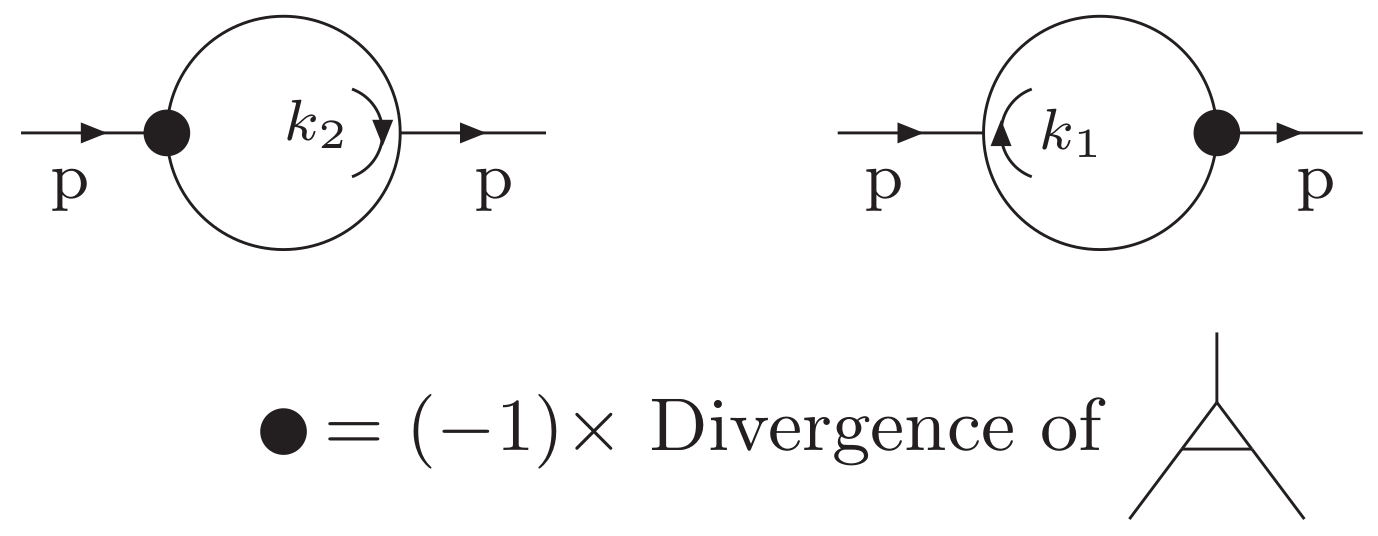

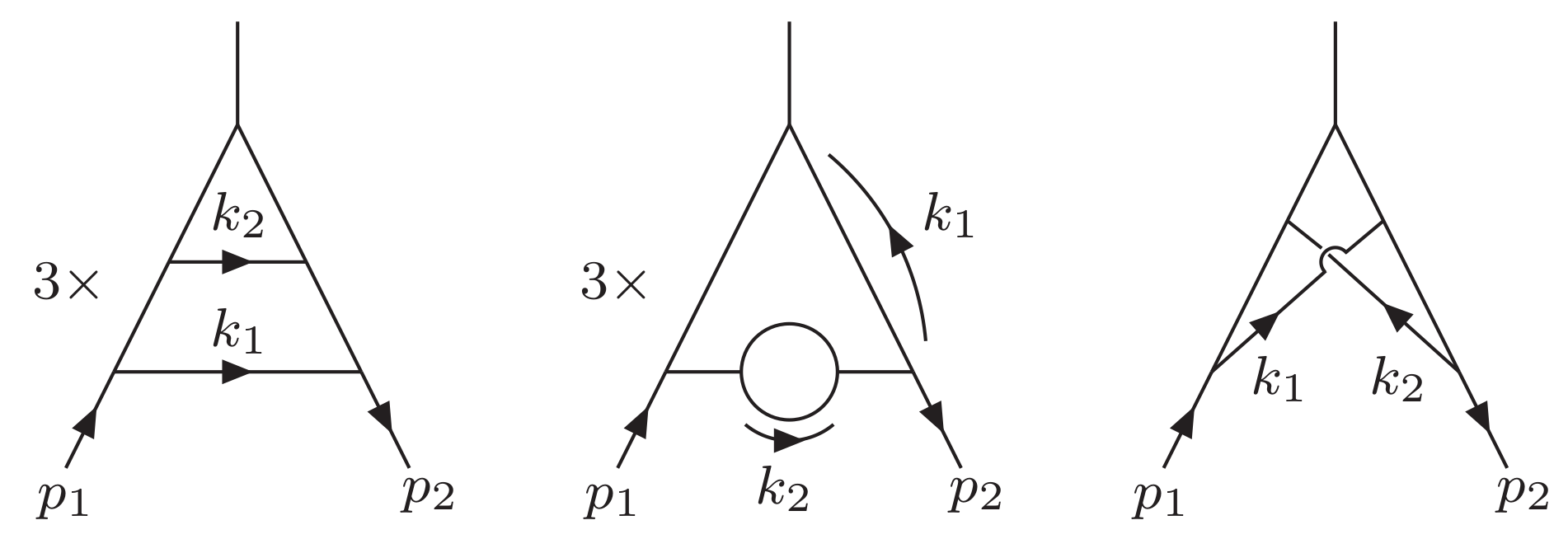
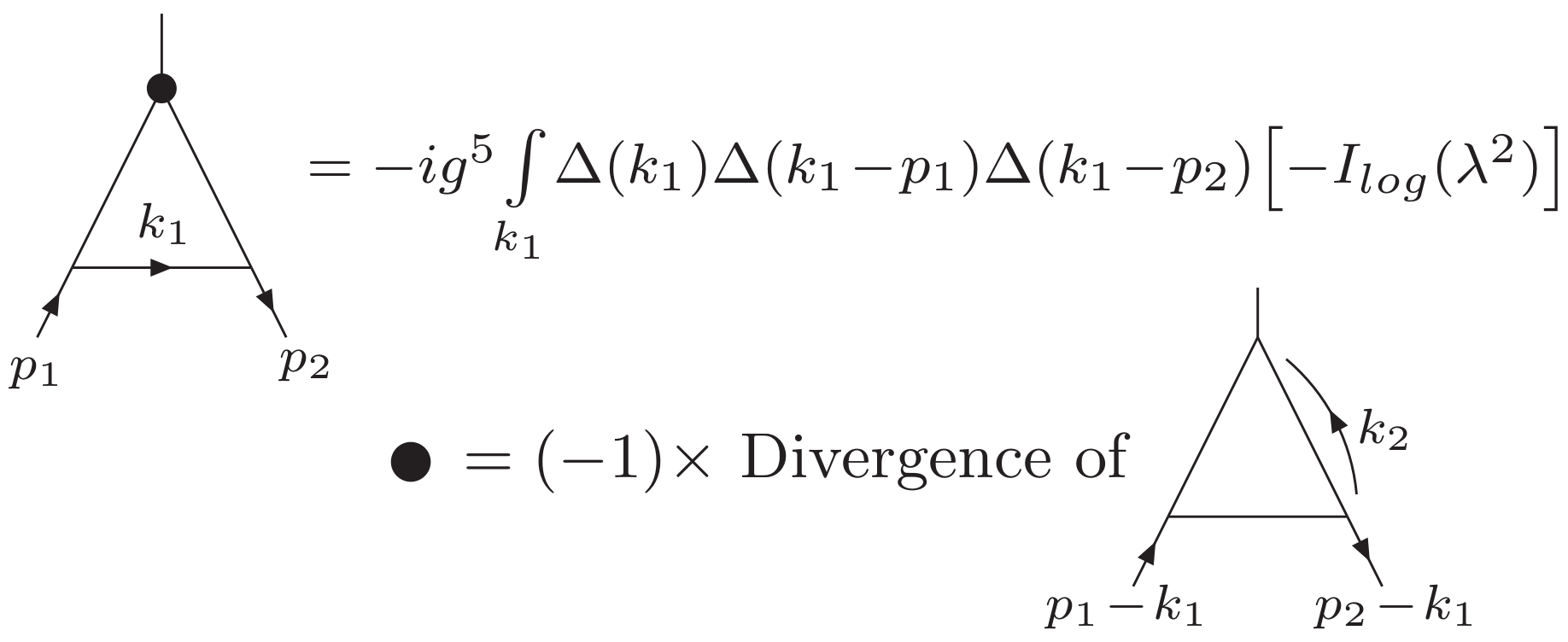

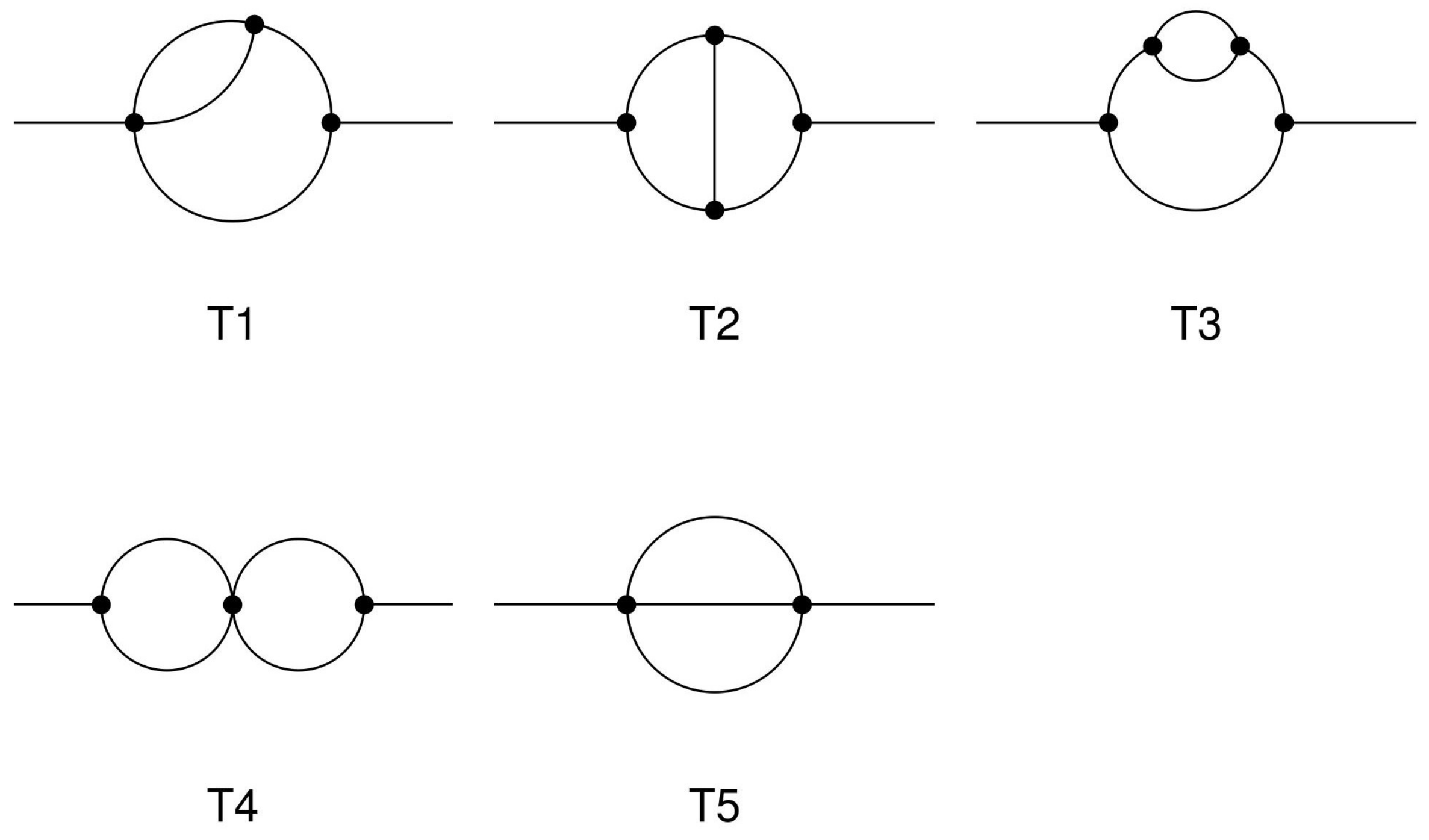
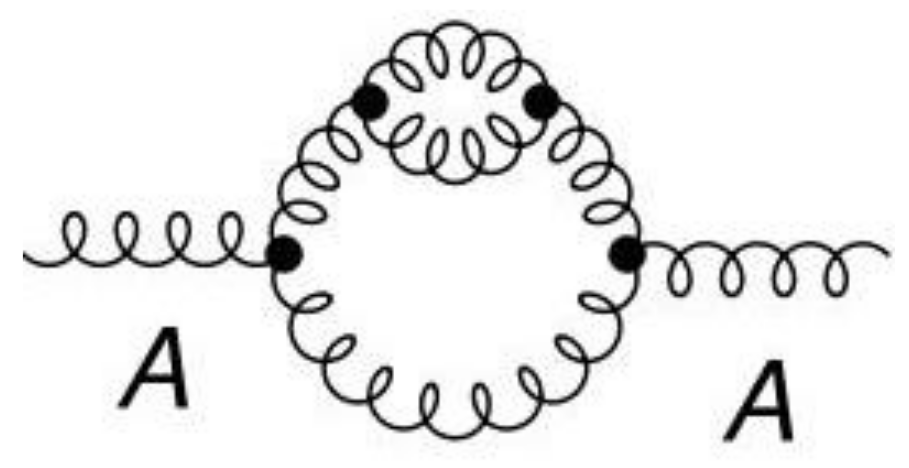
Publisher’s Note: MDPI stays neutral with regard to jurisdictional claims in published maps and institutional affiliations. |
© 2021 by the authors. Licensee MDPI, Basel, Switzerland. This article is an open access article distributed under the terms and conditions of the Creative Commons Attribution (CC BY) license (https://creativecommons.org/licenses/by/4.0/).
Share and Cite
Arias-Perdomo, D.C.; Cherchiglia, A.; Hiller, B.; Sampaio, M. A Brief Review of Implicit Regularization and Its Connection with the BPHZ Theorem. Symmetry 2021, 13, 956. https://doi.org/10.3390/sym13060956
Arias-Perdomo DC, Cherchiglia A, Hiller B, Sampaio M. A Brief Review of Implicit Regularization and Its Connection with the BPHZ Theorem. Symmetry. 2021; 13(6):956. https://doi.org/10.3390/sym13060956
Chicago/Turabian StyleArias-Perdomo, Dafne Carolina, Adriano Cherchiglia, Brigitte Hiller, and Marcos Sampaio. 2021. "A Brief Review of Implicit Regularization and Its Connection with the BPHZ Theorem" Symmetry 13, no. 6: 956. https://doi.org/10.3390/sym13060956
APA StyleArias-Perdomo, D. C., Cherchiglia, A., Hiller, B., & Sampaio, M. (2021). A Brief Review of Implicit Regularization and Its Connection with the BPHZ Theorem. Symmetry, 13(6), 956. https://doi.org/10.3390/sym13060956






